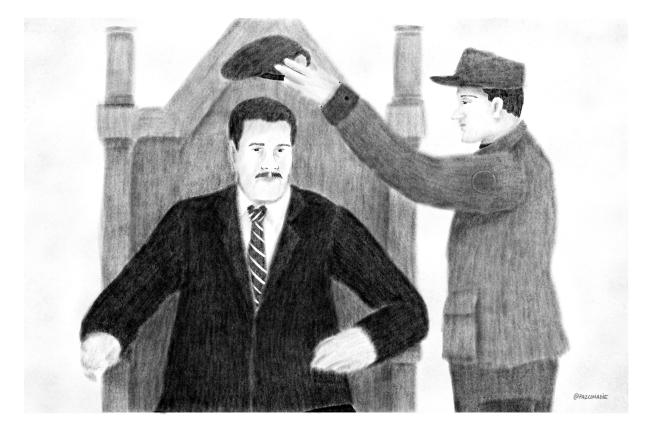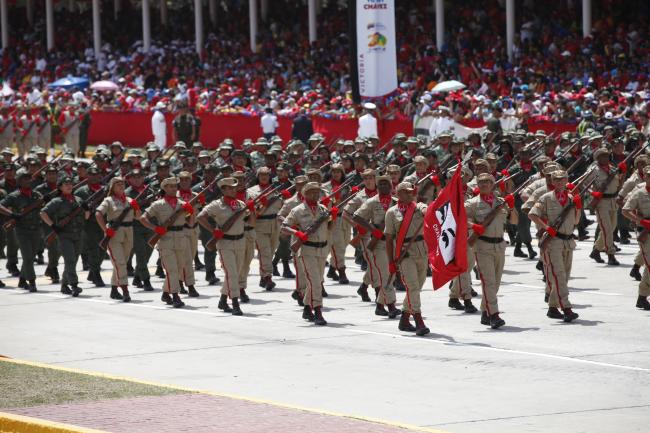
This piece appeared in the Winter 2023 issue of NACLA's quarterly print magazine, the NACLA Report. Subscribe in print today!
“In a perfect example of civil–military union,” reads a tweet posted in 2017 on the official account of the Bolivarian National Armed Force (FANB), “@VladimirPadrino supervises the distribution of [food baskets] in Valles del Tuy.” In one of three photos included with the tweet, Venezuelan defense minister General Vladimir Padrino López squats over a large map spread on the floor. Dressed in uniform and pointing to an area on the map, Padrino López’s pose suggests a similarity between food distribution to poor Venezuelans and the logistics of deploying troops across a conflict zone.
The imagery reminiscent of war is no coincidence. President Nicolás Maduro created the food distribution program through Local Supply and Production Committees (CLAP) in April 2016 to counter the effects of what he called an “economic war,” which he blamed on the Venezuelan elites. Food shortages, speculation, and the hoarding of basic goods like flour and toiletries were commonplace at the time.
“It is a tremendous battle to stabilize the entire economy, identifying the evildoers who wage war against the people and taking away their power,” said Maduro during a state television broadcast announcing the program. In a separate address, he added: “An economic revolution has begun in the food distribution system of Venezuelans by means of socialism.”
To coordinate the “battle” for food distribution, Maduro put Padrino López in charge of an ambitious social program, the Gran Misión de Abastecimiento Soberano (Great Sovereign Supply Mission), one of dozens of similar social missions that became a signature of Hugo Chávez’s government beginning in 2003. With activities spanning the food supply chain—encompassing production, distribution, commercialization, regulation, and development for import substitution—Misión Abastecimiento aimed to shore up the supply of food, medicine, and hygiene products, with ripple effects in other areas like seed production and animal feed. During the initial announcement, Maduro described the program as “a major civil-military effort, the first civil-military Misión to be created.”
Couched in a logic of security, defense of national sovereignty, and development, Misión Abastecimiento offers one example of how Venezuela’s Armed Forces under Maduro are involved in every activity deemed strategic by the Venezuelan state. This builds on a gradual shift beginning under Chávez in the early 2000s that has transformed the Venezuelan Armed Forces materially, symbolically, and ideologically. The government’s strong control over the Armed Forces became clear aft er the opposition tried and failed to encourage mass desertions to boost self-declared interim president Juan Guaidó in 2019. Today, given the limitations of the ruling United Socialist Party of Venezuela (PSUV) to serve as vanguard of the revolution, the FANB has embraced that role.
This is best illustrated in the rising proportion of military officials occupying key ministries. In 2014, a quarter of the cabinet was made up of military officers. By September 2023, according to the civil society organization Control Ciudadano, 13 of 33 ministers in Maduro’s cabinet—roughly 40 percent—were military officers, and 9 of those 13 were on active duty. Generals and former generals now run ministries overseeing food, agriculture, oil, mining, water resources, transport, energy, housing, and public works, in addition to defense and security, justice, and prisons.
Meanwhile, in June 2022, the Maduro government launched the Community–Military Brigades for Health and Education (BRICOMILES), deploying the Armed Forces into schools and health centers to repair decaying infrastructure. When community-based organizations, such as communes and communal councils, request services like rebuilding, repainting, and facility upgrading, the Armed Forces send troops to carry out the works locally.
Maduro has described BRICOMILES as “a solution that brings together the people and the FANB even more.” He added: “We have to be united—popular power, military power, social power, political power. We must continue working together with the people.”

As with social programs, the influence of the Armed Forces over strategic sectors of the economy has also grown, particularly under Maduro. Transparencia Venezuela, a chapter of the anti-corruption organization Transparency International, describes the Armed Forces as “a corporation with increasing economic power in several areas of business.” The FANB owns at least 24 companies in areas including banking, construction, agroindustry, oil and gas, mining, and transport, according to a November 2021 report by Transparencia Venezuela. Crucially, all but six of all military-owned enterprises came into existence under Maduro. In addition, military officers sit on the boards of more than one in 10—a total of 103—of the 925 companies that are completely or partially publicly owned.
A March 2022 report by Control Ciudadano notes that military-owned companies often “perform unconstitutional activities, incompatible with those attributed to the FANB.” According to the report, Compañía Anónima Militar de Industrias Mineras, Petrolíferas y de Gas (CAMIMPEG), a military limited company created in 2016 to carry out extractive activities in the mining, oil, and gas sectors, and Empresa Militar para el Aprovechamiento Sustentable de Productos Forestales y Recursos Naturales SA (EMASPROFORN), established in 2020 to make sustainable use of natural and forest resources, are among the most controversial of the lot. These two companies’ “environmental exploitation activities,” the report notes, “are irreconcilable with the role of environmental guardian assigned to the military institution.”
The government justified the creation of CAMIMPEG in 2016 citing the need to secure national resources in the context of a global energy race, but the opposition expressed concerns that it could weaken oversight in the oil sector—Venezuela’s main source of income and a provider of endless opportunities for corruption.
The Changing Role of the Army
It may seem an apparent contradiction that the Armed Forces in Venezuela are much more prominent under Maduro, a civilian, than Chávez, a former military officer. But the two men are simply different stages of the same historical process, and there is more continuity between them than is often acknowledged.
Three years after Chávez entered office, a short-lived coup between April 11 and 13, 2002 made a lasting mark on Venezuelan politics. Chávez was deposed and whisked away on helicopter to an island in the Caribbean, where he was held incommunicado for several hours before triumphantly returning to office. In the wake of the failed coup, Chávez began a long and continuous process of purging the Armed Forces of dissent. Particularly after surviving a recall referendum and winning local elections in 2004, Chávez used his personal influence and huge political and electoral capital to spur the Bolivarian Revolution’s salto adelante or “leap forward” after 2005, beginning by defining it as “socialist” and doubling down on the nationalist and anti-imperialist rhetoric. Under this new direction, the military was given the strategic role of defending the revolution by expanding its reach into virtually every area of Venezuela’s economy and society to protect it from the threat of U.S. imperialism and the local and regional elites.
Venezuela’s military doctrine and education was radically redrawn, making way for the “new military thinking,” which entailed close alignment between the Armed Forces and the government’s socialist ideology. Chávez took personal control of military promotions and made the president the main adjudicator between each force—a classic example of divide and rule aimed at ensuring loyalty. In 2008, he created a new civil–military body, the Bolivarian Militia, which was ideologically closer than others to the regime and under direct orders from the president.
But it was under Maduro, who took over after Chávez’s death and narrowly won elections in 2013, that this new model was fully implemented. Unable to count on Chávez’s popularity and facing emboldened opposition—and, after 2014, mass protests and a decline in oil prices—Maduro greatly extended the military’s power and clout. Not surprisingly, nowadays the Venezuelan military is often referred to as a “kingmaker,” and its support for Maduro is depicted as a kind of bargain or quid pro quo in exchange for power. But that view ignores how deep the transformation already was before Maduro. It also risks underestimating the extent to which the military is integrated with the regime and a key stakeholder in its outcomes.
Chávez’s election in 1998 empowered a nationalist wing of the Venezuelan Armed Forces who believed the military should play a larger role in national development—a position that appealed to officers from various ideological backgrounds. Although this idea is often associated with the national security doctrines of the Southern Cone in the 1970s, it is not unique to conservative armies. In Peru, the progressive government of Juan Velasco Alvarado (1968-1975), one of Chávez’s early inspirations, viewed agrarian reform as a crucial part of the army’s fight against Marxist-Maoist guerrillas. Improving living standards for the poor, this strategy reasoned, could help prevent rural residents from being co-opted by rebel groups.
Venezuela’s 1999 Constitution gives the Armed Forces a broad role in society, assigning it the missions of external defense, assisting with maintenance of the internal order, and active participation in national development (Article 328). It defines security as a concept “founded on the integral development” of the nation (Article 322) and a “co-responsibility” of state and society, encompassing “economic, social, political, cultural, geographical, environmental and military areas” (Article 326). Later, in July 2007, then Defense Minister Raúl Isaías Baduel—who eventually broke with Chávez and ultimately died in prison in 2021—referred to the triad of “external defense– internal security–national development” as “the three fundamental missions” of the Armed Forces. Early on, the most important initiative to reflect the new roles given to the Venezuelan Armed Forces was Plan Bolivar 2000. Although the Armed Forces had participated in other civic action plans in the past, Plan Bolivar 2000 took the scope to a whole new level. The plan engaged nearly 40,000 soldiers in a vast array of projects, from poverty alleviation to infrastructure building, food distribution, and medical attention in poor areas.
But a significant turn and radicalization came after the 2002 coup attempt, which the United States had been quick to support. Soon after, the 2003 invasion of Iraq reinforced fears in Caracas of direct U.S. intervention. During a statement to Congress in 2004, General James T. Hill, commander of the United States Southern Command, drove the point home further when he singled out Venezuela, Bolivia, and Haiti as nations where political events “represent an increasing threat to U.S. interests” in Latin America.
In Caracas, a shift in rhetoric and ideology was already underway. Chávez acknowledged this evolution in May 2008 while addressing members of his newly created political party, PSUV. “From 2002, our process began to radicalize,” he told supporters. “Leon Trotsky said, every revolution needs the whip of counterrevolution. The counterrevolutionary and fascist whip spurred us on.” He called anti-imperialism and socialism—tenets he explicitly embraced in 2003 and 2005, respectively—the two defining banners of the Bolivarian Revolution. “This revolution will be more anti-imperialist and more socialist every day,” he declared.
The Armed Forces were seen as key to these processes: a powerful deterrent against external and internal enemies of the revolution and an important source of resources, human and material, to carry out and promote socioeconomic transformation.
Read the rest of this article, available open access for a limited time.
Pablo Uchoa is a journalist, PhD candidate at the UCL Institute of Americas in London, and former visiting scholar at the John W. Kluge Center at the Library of Congress in Washington, DC.

